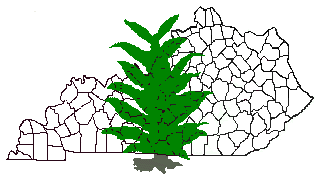

 Cutworm damage was reported late last week on
newly set tobacco in Madison county. The cutworms
were feeding above and below ground. Cutting was
estimated at 1% of the stand and the worms found
were large. Feeding should end soon and the chance
of greater stand loss is small.
Cutworm damage was reported late last week on
newly set tobacco in Madison county. The cutworms
were feeding above and below ground. Cutting was
estimated at 1% of the stand and the worms found
were large. Feeding should end soon and the chance
of greater stand loss is small.
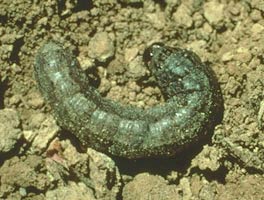 Above ground feeding by cutworms increases the
prospect for control because the larvae will ingest the
insecticide as they feed on plant leaves. Control
usually is less satisfactory when the insects are
feeding only below ground and there is minimal
contact with the treated soil surface.
Above ground feeding by cutworms increases the
prospect for control because the larvae will ingest the
insecticide as they feed on plant leaves. Control
usually is less satisfactory when the insects are
feeding only below ground and there is minimal
contact with the treated soil surface.
In virtually all cases, we are dealing with nearly full grown cutworms. In most cases, the amount of cutting that occurs during about the first 5 days after transplanting should be the extent of the injury. If cutting is limited to scattered plants, there should be compensation by neighboring plants with no yield loss. Gaps of 3 or more missing plants is where compensation cannot make up for the missing plants.
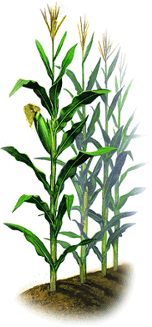
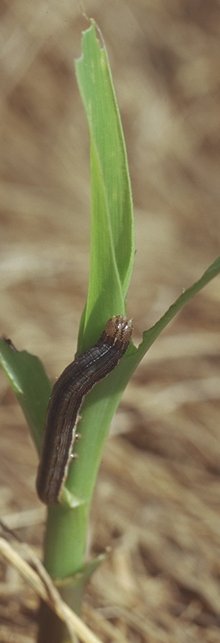 Armyworm damage has been reported in central
Kentucky. Corn producers should pay particular
attention to no-till fields and conventional tillage
fields adjacent to grassy waterways and small grains
for armyworms. When scouting fields, look for
characteristic armyworm feeding on leaf margins and
feeding around the whorl. Cool, wet, spring weather
usually favors armyworm development and there has
been considerable moth activity over the last several
weeks. Smaller plants and less rapidly growing plants
may show signs of severe damage.
Armyworm damage has been reported in central
Kentucky. Corn producers should pay particular
attention to no-till fields and conventional tillage
fields adjacent to grassy waterways and small grains
for armyworms. When scouting fields, look for
characteristic armyworm feeding on leaf margins and
feeding around the whorl. Cool, wet, spring weather
usually favors armyworm development and there has
been considerable moth activity over the last several
weeks. Smaller plants and less rapidly growing plants
may show signs of severe damage.
Are small larvae more damaging than large ones? While a 1-1/2 inch armyworm will consume more in a night than one that is only a 1/2 inch long, the smaller armyworm will be more destructive because it has most of its feeding left to do. For this reason, it usually does not make sense to treat an armyworm infestation if most of the larvae found are between 1 and 1-1/2 inches long.
If the characteristic armyworm damage is observed while scouting, look on the ground for armyworms or their black pepper-like droppings littering the ground. Remember, during the day, armyworms hide in soil cracks or under clods and crop residues. Armyworms usually feed only at night but some may be found in the whorl of the plant during the day. To sample for armyworms, examine 20 consecutive plants in each of at least 5 random locations in the field. Note the number of plants with the characteristic damage and the size of the larvae. Use 35% as the economic threshold.
While scouting, look for parasitic fly eggs behind the
heads of the armyworms. These eggs are minute, light
yellow, and shaped like rice. Armyworms with these
eggs behind their heads should NOT be counted
when determining if armyworms exceed the
economic threshold.
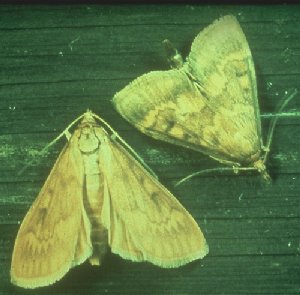 European corn borer moth flight continues across
most of the Commonwealth, so producers should
continue to monitor fields for window pane damage
and young larvae during the next few weeks.
Higher
levels of European corn borer can be expected in
fields with earlier planting dates and more advanced
corn or in fields that have excessive weed growth
around field margins. Where Bt corn is grown,
producers should monitor the Bt corn as well as the
refuge corn.
European corn borer moth flight continues across
most of the Commonwealth, so producers should
continue to monitor fields for window pane damage
and young larvae during the next few weeks.
Higher
levels of European corn borer can be expected in
fields with earlier planting dates and more advanced
corn or in fields that have excessive weed growth
around field margins. Where Bt corn is grown,
producers should monitor the Bt corn as well as the
refuge corn.
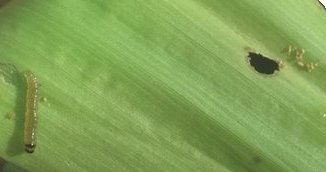

I've received a report of very active powdery mildew in some red clover fields in the Mammoth Cave area of southern Kentucky. Powdery mildew appears as a white or light gray, powder-like growth over the upper surface of leaf blades. Although it is not uncommon to find occasional plants in a field with severe powdery mildew, some fields inspected in southern Kentucky exhibited uniformly high levels of powdery mildew across the entire area examined. Normally, powdery mildew occurs in late summer and autumn, so the severe occurrence this early in the season is uncommon.
Red clover fields are approaching or at the early stages of flowering, and are at an excellent stage to cut for high-quality forage. Although powdery mildew may have already reduced forage quality slightly in affected fields, cutting or grazing now will help reduce further losses in quality as the disease progresses further. Powdery mildew can affect quality or harvested forage, although it usually has little impact on yield or stand life by itself.
Armyworms have been active in wheat so far this season (see corn article). Some are no doubt present in chopped wheat stubble that is being planted to soybeans now. Armyworms will eat soybeans, especially when there is no other choice and damage may be spotty but intense.
Scouting is the only way to determine their presence and to catch damaging infestations in time to provide a corrective action if it is needed. Scout fields following emergence to determine whether the insect is present. A rescue treatment is justified when stand loss or defoliation reaches 30%.
Growers in Kentucky now have three different broad- spectrum fungicides called strobilurins available for managing diseases of grapes and apples. The fungicide Abound (azoxystrobin) from the Zeneca Company was available for grapes last year for managing black rot, powdery mildew and downy mildew. This year, apple and grape growers have two more strobilurins, Sovran (kresoxim-methyl) from the BASF Company and Flint (trifloxystrobin) from the Novartis Company. Sovran and Flint provide excellent control of apple scab, powdery mildew, sooty blotch, flyspeck, black rot, and some control of cedar apple rust and quince rust, depending on rates used. The new strobilurin chemistry is a welcome addition to the list of fungicides available not only because they are effective, but also because they should help to slow the development of resistance to other fungicides such as the sterol inhibitor (SI) fungicides (e.g. Nova, Procure). Ideally, each fungicide group helps keep the others effective longer.
Origin of strobilurin fungicides. Strobilurin chemistry was derived from a natural anti-fungal compound that occurs in a small mushroom, Strobilurus tenacellus, which grows on fallen pine cones in Europe. Chemists in several companies modified the original compound to make it more stable and more effective as a fungicide. The strobilurins are very active against a wide array of plant pathogenic fungi, generally at rates of only one to three ounces of active ingredient per acre. They have very low toxicity to birds, earthworms, beneficial insects, predaceous mites, and mammals (including humans). They break down quickly in soil but have good residual activity on foliage and fruit. Because of their broad spectra of activity and favorable environmental profiles, they are the most significant new group of fungicides to be developed since the SI fungicides.
How strobilurin fungicides work. Unlike the SI fungicides, the strobilurins are excellent inhibitors of spore germination; thus, they are excellent protectant fungicides. These materials are retained primarily within the waxy cuticle of leaves and fruit, which means that they are more rain-fast than traditional protectants. This also means that they don't redistribute very well from leaf to leaf in rainwater, although they do redistribute well within the waxy layers of a given leaf or fruit. Furthermore, a small portion of the total dose does diffuse from the surface of a sprayed leaf and, after a few days, enough accumulates on the other side so that it offers fungicidal protection on that unsprayed side (trans- laminar activity). This general pattern of fungicide movement is unique to the strobilurins, and different manufacturers have devised their own trademarked names to describe it, e.g., "surface systemic" for Sovran and "mesosystemic" for Flint. These terms are used in their advertisements.
In addition to being excellent protectant fungicides, the strobilurins are powerful antisporulants. That is, when applied beyond their period of true "kickback" activity, they allow lesions to develop but few secondary spores form on these lesions. This is particularly significant for a disease like apple scab, where economic damage (fruit scab) is usually caused by the secondary spores that develop on infected leaves. In experiments where fungicides were not applied to the first cluster leaves to manage early infection periods, significantly less fruit scab developed when the next two subsequent sprays consisted of a strobilurin rather than an SI plus mancozeb. This reduction in fruit scab was directly related to the reduced number of sporulating lesions produced on cluster leaves treated with strobilurins versus those treated with other materials.
The strong protectant and antisporulant activities of these materials are functions of their retention in the cuticle on the surface of the leaves and fruit. Conversely, good curative or kickback activity usually requires a fungicide to penetrate the cuticle and get inside the leaf, i.e., to get down where the fungus is "doing its business" after it's established an infection. Thus, the strobilurins generally are not as effective in a kickback mode as are compounds with a higher degree of systemic activity, such as the SI fungicides. However, apple scab may provide an exception to this general rule because the apple scab fungus grows just beneath the cuticle, so that enough fungicide to provide true post-infection control may actually "leak through" the underside of the cuticle and do the job. Both Flint and Sovran are labeled to provide approximately 4 days of post-infection control for apple scab. However, it is not clear whether post- infection sprays truly kill the incipient infections or merely keep them from sporulating (in which case, they could potentially reactivate without additional applications of the fungicide). There is no question that Sovran and Flint provide scab control when applied just after infection, but it seems risky to deliberately design post-infection control programs with these materials until more is known.
Used alone, Sovran and Flint will perform in the orchard similarly to tank mixes of SI and contact protectant fungicides. It is important to recognize that these strobilurin fungicides control scab (and many other diseases) on apple fruit at least as effectively as mancozeb and captan, and much more effectively than SI fungicides when applied alone. For strobilurins, spray intervals of greater than 10 or 11 days are not recommended during the primary scab season, due in part to the need to cover new tissues as they emerge.
Fungicide resistance? Strobilurin fungicides work by inhibiting a single biochemical pathway involved in mitochondrial respiration in fungal cells. Mitochondria are the energy-producing units within cells, so disrupting mitochondrial function results in death of the fungal cells as they "run out of gas." Because strobilurins inhibit a single biochemical step, resistant strains of various pathogens will develop if these fungi can utilize an alternative biochemical pathway that bypasses the step blocked by strobilurins. Resistance to strobilurins has already appeared in powdery mildews of cereal grains and cucurbit crops in Europe and Asia, as well as in Botrytis of greenhouse crops. Thus, resistance is a very real concern, and resistance management must be incorporated into plans for using strobilurin fungicides from the beginning.
To date, strobilurin resistance appears to follow the "Benlate model;" that is, resistant isolates are virtually immune to the fungicides and multiply rapidly if they are not controlled by some other material. Furthermore, a fungal strain that is resistant to Sovran or Abound will be resistant to Flint and vice versa. Therefore, the manufacturers have agreed on similar labeling which requires use patterns that incorporate resistance-management principles. Growers must limit the number of times that a strobilurin may be used per season to 4 or 5; and they must not use a strobilurin fungicide more than two or three times in a row. If two applications are made in sequence, an effective unrelated fungicide must be used in the next two applications before strobilurin use can resume.
Note that tank-mix combinations are not a part of this strategy, and that both fungicides are priced to be used alone. Thus, this strategy minimizes the selection of resistant strains by limiting the number of selection events (sprays); and limits the opportunity for resistant strains to multiply, by using unrelated fungicides in rotation. Restricting the number of sequential strobilurin sprays to two might be the more effective anti-resistance strategy, although three is legal. Economics will help enforce the limited-spray strategy, but it is important that growers not deliberately short-circuit the intent to limit the buildup of resistant fungus strains; e.g., by failing to rotate with effective unrelated materials. For instance, rotating Flint or Sovran with only benzimidazole/captan sprays would not be a good resistance-management strategy for powdery mildew, because the mildew fungus is already resistant to the benzimidazoles in many orchards.
Strobilurin use patterns. Growers will need to decide the best times in the season to use the strobilurin fungicides. Be aware that the strobilurin fungicides are strong against scab and powdery mildew, weaker against cedar rusts, and strong against sooty blotch and flyspeck. The best timing for use could be to apply strobilurins twice in spring at around bloom time and again twice in early summer, using other fungicides very early in spring and in late spring and late summer. There has been little research done to determine the timing of these fungicides for best sooty blotch and flyspeck control.
Strobilurin fungicides can be phytotoxic to some crops. Abound is phytotoxic to certain apples with McIntosh parentage, so it is not registered for apples. Apples sprayed with contaminated sprayers or receiving drift from applications to grapes can also be affected. Sovran is phytotoxic to a few sweet cherry varieties and therefore will not be registered for cherries. Flint is phytotoxic to Concord grapes and is specifically not labeled for use on that variety. Thus, each of these strobilurins has a problem with phytotoxicity to a few varieties of one specific crop. Fruit growers producing apples and stone fruits or apples and grapes may wish to consider the potential for phytotoxicity when selecting which of these fungicides they will use on their farm.
Parts of this report were adapted from an article printed in the Scaffolds fruit newsletter written by Wayne Wilcox and Dave Rosenberger, of Cornell University.
An important issue in Kentucky's adjustment to commercial vegetable production will be learning and properly reacting to disorders and infectious diseases of many new crops. Therefore, accurate and timely diagnosis of vegetable diseases and disorders will be critical to disease management. Knowledge of the specific problems that occur in a given field or on a certain variety allows one to incorporate the appropriate controls into the total plan. Without a sound diagnosis the control programs will likely be unfocused, or even "shots in the dark", costly in losses, and lead to irresponsible use of pesticides. Consequently, I urge vegetable growers not to under estimate the importance of this issue.
Kentucky's County Extension Agents for Agriculture have all been trained to assist growers in obtaining accurate and timely diagnosis of diseases and disorders through using the two UK Plant Disease Diagnostic Laboratories, at Princeton and Lexington, operated by the College of Agriculture. They have learned that well from helping tobacco growers! Most of Kentucky's Extension Agents do not have the experience necessary to qualify them to diagnosis on- site the important diseases of commercial vegetables. However, Extension Agents do know where to get assistance.
County Extension Agents will need growers' help in sorting out the problems and obtaining good samples. All need to understand that an inadequate sample or poorly timed one will usually result in an incomplete or misleading diagnosis. Moreover, growers sometimes set themselves up to receive bad advice by attempting to have problems diagnosed over the phone or months after the event occurred. Try that phone call sometimes with your local physician or veterinarian - " Doc, what is causing my left arm to wilt? Or, I lost three cows last year, what should I do next year to keep them from dying?" Instead, I strongly urge growers to take the time while the problem is developing to collect appropriate samples and get them to the agents. In this way, one will have the diagnostic information related to the specific problem rather than someone's guess at what the problem may have been.
The following are some tips to guide your efforts:
1. Scout every vegetable planting frequently and regularly. If you do not know the cause of the problem, get it accurately diagnosed. Watch for changes in plant appearance. Identify the specific problem(s) and note when and where they are occurring. Be watchful for both disorders that appear to be spreading to other plants and those that appear to make some individual plants worse but do not spread. They may be the type that will be waiting next year! Make a record of what was found - field by field.
2. Careful attention to patterns is critical to diagnosis. If nearly all plants have the problem, the cause is usually something other than an infectious agent, or infected plants were set to the field. Infectious diseases usually start with a few plants or as a small cluster and spread with time. Determine whether a pattern exists among the affected plants. If so, can anything be correlated with the pattern? Specifically, look at drainage, soil type, shade, cultivation patterns (transplanting patterns, spray patterns, etc.). When a pattern is present, the materials should be collected from both the "good" and "bad" areas so that the findings can be directly correlated with the patterns. The pattern, more often than not, will yield the key clues needed in the diagnosis and the control!
3. Knowing when things are happening is also critical to diagnosis and the timing of control. So maintain excellent records of what was done and when it was done, and share them with those involved in diagnosis. Do not expect to receive the right answers when important clues are hidden. Previous events become valuable clues to predicting agents of predisposition and to determining why a control failed. Sometimes the grower has selected the correct control for the problem but has used it poorly. The greatest help we give following many diagnoses is to aid in better timing of controls. An "old-timer" once said after a long career in agriculture: " Timing is the main difference between success and failure in farming."
4. Examine the plant carefully for symptoms (all of the plant including the roots). Collect several whole plants (by digging, not by pulling) representing a range of stages of the disease or disorder, plus at least one healthy plant. Why the healthy plant? Because the healthy plant may not be as healthy as it appears (especially to the new grower), and poor health can predispose plants to certain other problems. The overall of health needs to be considered when considering control cost-benefit issues. Be sure to include soil and roots with the samples (half the plant is under ground).
5. Be sure to rule out soil nutrient problems both deficiencies and toxicities. No commercial vegetable crop should be planted without a soil test. Soil test results and fertilizers used should be made available to the person making the diagnosis. Additional nutrient analysis may be required when making the disease assessment.
6. Know the variety. Know what pesticides were used (when and how much).
7. Take the plant samples and all the information available to the County Extension Office. If the agents are unable to identify the problem and the grower has collected carefully, the agents have what they need to submit samples to specialists at the University. There is no charge to Kentucky growers for this service.
In Kentucky, most plant disease diagnostic activities are supported by public funds rather than charged directly to the grower. As a result, our findings are used to help not only the specific individual with the problem but other growers in similar circumstances. The biggest cost to both the individual grower with the problem and to the public is in time wasted with poor samples. Thus, an inadequate sample is of little value and may be misleading.
Several mite species have been abundant this spring. Winter survival of clover mites, winter grain mites, and wheat leaf curl mites has been excellent. It is likely that chiggers and ticks will have come through well, also. The steps for protection against chiggers will be good for ticks, too.
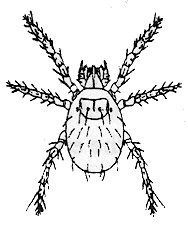 Chiggers are the larvae of a family of mites that are
sometimes called redbugs. Adults are large red mites
that can be seen running over pavements and lawns.
Chiggers are extremely small (0.5 mm). They occur
outdoors in low, overgrown damp places. These
mites feed on a variety of wild and domestic animals,
as well as humans. Wild blackberry patches and
grassy woods margins also are mite territory because
of they harbor many small rodents that are good
hosts.
Chiggers are the larvae of a family of mites that are
sometimes called redbugs. Adults are large red mites
that can be seen running over pavements and lawns.
Chiggers are extremely small (0.5 mm). They occur
outdoors in low, overgrown damp places. These
mites feed on a variety of wild and domestic animals,
as well as humans. Wild blackberry patches and
grassy woods margins also are mite territory because
of they harbor many small rodents that are good
hosts.
Chiggers overwinter as adults in the soil, becoming active in the spring. Eggs are laid on the soil surface. Newly hatched larvae crawl about until they locate and attach to a suitable host. Larvae feed for about 4 days and then drop off and molt to nonparasitic nymphal stage and ultimately the adult. The life cycle (from egg to egg) is completed in about 50 days.
Chigger bites commonly occur around the ankles, waistline, armpits, or other areas where skin is tender or where clothing fits tightly. These mites do not burrow into the skin but feed at pores or hair follicles. A salivary fluid is injected which dissolves cell tissue and produces a hardened, raised area around the site. Lymph, dissolved body fluids, and stray blood cells are withdrawn from the host through a feeding tube.
Most people react to chigger bites by developing an itch within 4 to 6 hours and dome-shaped reddish welts within 24 hours. Intense itching accompanies the welts, which may persist for 7 to 10 days. Besides causing intense itching, chigger bites that are scratched may become infected. Chiggers in North America are not known to transmit disease.
People who suspect they may have been attacked by chiggers should take a soapy bath immediately and apply antiseptic to any welts. A local anesthetic will provide temporary relief from itching.
Persons walking in chigger-infested areas can be protected by treating clothing (cuffs, socks, waistline, sleeves) or exposed skin with tick repellents. Some repellents should only be used on clothing; and it is important to follow label directions.
Regular mowing and removal of weeds and brush make areas less suitable for chiggers and their wild hosts. Mowing also enhances penetration and performance of miticides, should they be required. Chigger populations can be further reduced by treating infested areas with residual miticides. Applications should be thorough but restricted to areas frequented and suspected of being infested.
For more information, see Entfact-630 "Chiggers"

In the Diagnostic Lab, we are still seeing a variety of virus and other disease problems on wheat: wheat spindle streak mosaic, wheat streak mosaic, and barley yellow dwarf, as well as powdery mildew. On tobacco we have seen more Pythium root rot, target spot and Sclerotinia collar rot.
On fruits and vegetables, we have diagnosed anthracnose (foliar and petiole lesions) on strawberry; Fusarium stem canker on basil; wirestem (Rhizoctonia) on cabbage; and Fusarium crown rot on asparagus.
On landscape ornamentals we have seen predominately two diseases: maple anthracnose and apple scab (on crabapple). These two diseases were mentioned in Dr. Hartman's article in KPN last week (May 8) and created quite a stir in the lab this week with dozens of samples and phone calls coming in. Also seen were necrotic ringspot on bluegrass and Pythium root rot on geranium.

| UKREC-Princeton, KY, May 5 - 12, 2000 | |
| Black Cutworm | 7 |
| True Armyworm | 15 |
| Corn Earworm | 12 |
| European Corn Borer | 2 |
Details are posted on the Pesticide Applicator Training Web Site
http://www.uky.edu/Agriculture/PAT/welcome.htm

Several new Entfact publications are available. They can be found on the UK Entomology web page http://www.uky.edu/Agriculture/Entomology/enthp.htm. They are in both HTML and PDF format for use at county extension offices. These were issued during the summer and fall of 1999.
Entfact 127 Alfalfa weevil field sampling program
Entfact 128 Bt-corn refuges
Entfact 129 Lesser cornstalk borer
Entfact 130 Bt Corn: What it Is and How it Works
Entfact 216 Leafrollers
Entfact 218 Apple Bagging: Alternative Pest Management for Hobbyists
Entfact 315 Cabbage Webworm
Entfact 441 Insecticides for Control of White Grubs in Turf Grass
Entfact 442 Velvet Ants
Entfact 507 Lesser Mealworms and Litter Beetles
Entfact 508 Walk Through Fly Trap for Pastured Cattle
Entfact 509 Horn Flies and Cattle
Entfact 510 Face Flies and Pinkeye
Entfact 511 Horse Flies and Deer Flies
Entfact 642 Do-it-yourslef Termite Baits: Do They Work?
Entfact 643 Limitation of Home Insect Foggers ("Bug Bombs")
Entfact 644 Consumer Update: Termite baits
Entfact 645 Millipedes
Entfact 646 House Dust Mite
Lee Townsend
Extension Entomologist